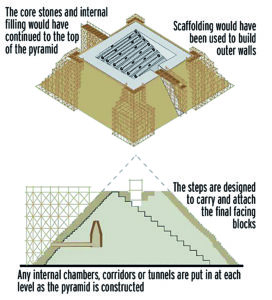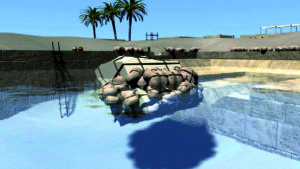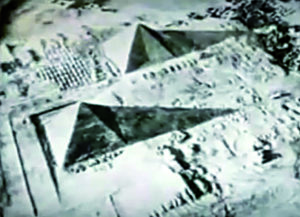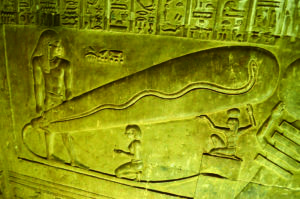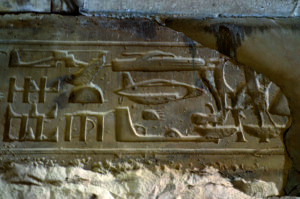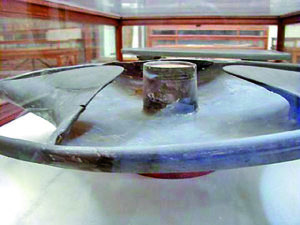New theories on the construction
of the Great Pyramid from 2008 to 2018
Since Houdin’s extended theory with the inner ramps in 2007 (see page 232), first introduced by Cayce in the 1930s, several new theories were published over the last 10 years. It is always a matter of how humans could accomplish the construction of these pyramids in the time of the 3 Pharaohs 4,500 years ago. The calculations are based on the Great Pyramid, because there most facts are known. Today, 201 stone layers with an average height of 0.7 m / 2.3 ft have been preserved. Most of the approximately 2.3 million bricks weigh 2.5 t / 5,000 lb and the cladding blocks up to 16 tons / 32,000 lb . With the cladding, the volume was 2,592,968 m3 / 91,569,800.7 ft3, resulting in a total weight of almost 7 million tons / 14,000,000,000 lb . These are the bases for the different calculations for the construction of the Great Pyramid, which are converted to the estimated reign of Cheops. Here are 2 models:
• A widespread calculation formula on the Egyptian basis is: During Cheops’ reign of 25 years, 21 blocks per hour had to be set annually in 365 days with 12 working hours.
Note:
If one takes today’s Egyptian assumption with the voluntary farmers as workers (without slaves), whose religious front work (in order to be able to go with into the afterlife) was limited to the three months of the Nile flood, it would be 84 laid stone blocks per hour. And if one adds the first 10 years for the construction of the required infrastructure (such as the construction ramp and the over 1 km / 3,280.1 ft long ascent from the Nile to the Giza Plateau 40 m / 131.2 ft higher), the necessary cadence increases to 141 laid stone blocks per hour.
• The detailed calculation of today’s engineers looks as follows:
It is based on an area of around 52,000 m2 / 559,723.342 ft2 (from the side lengths of 230 x 230 m / 754.7 x 54.7 ft ) and a well-organized construction site, which is divided into 520 construction plots of 1,076.391 ft2, for example, in which teams work in parallel. As an assumption for the synchronous factor, we estimate that 400 teams of 15 people will work here, resulting in 6,000 workers (per team/15 people on a working surface of 130 m2 / 1,399.308 ft2). At half the height of the pyramid, around 7/8 of the total volume is built, then the construction site still amounts to 1/4 of the base area, i.e. around 13,000 m2 / 139,930.8 ft2 . There it gets tight per team with 15 workers on a work surface of 32.5 m2 / 349.8 ft2, but the number of teams decreases continuously. In terms of figures, however, we still stick with the 400 or so teams that would be building in parallel, since, for example, more men are needed to raise the blocks higher and higher and deploy them. And if you assume a team of the same size for the supply, there would be 800 teams with a total of 12,000 men. Engineers now calculate a maximum reasonable weight output per hour and man and that would be around 15 kg / 33.06 lb per man and hour (after deduction of the lever technology that reduces the weight). Then the calculation of the required men takes place. The volume of the Great Pyramid is 2,592,968 m3 / 91,569,800.7 ft3, which gives a total weight of around 7 million t / 114,000,000,000 lb. That is 7 billion kg / 1.543 × 1010 lb, which divided by the 15 kg / 33.06 lb then result in 466,666,667 kg / 1.029 × 109 lb per men and hour. We now again compare this with the construction time of 25 years x 365 days x 12 hours, which results in 109,500 working hours. And if we now divide the 466,666,667 kg / 1.029 × 109 lb per men and hour by the 109,500 working hours, we arrive at around 4,260 men. If we compare this with the synchronous factor of 2.3 million blocks divided by 400 teams, this results in 5,750 blocks. So each team would have had 19 hours time for a stone block and so the construction would be imaginable (compared to 21 blocks per hour from the first model). Each team with 15 men x 19 hours would have 285 man-hours and each individual man would have a weight capacity of 9 kg / 19.842 lb per hour. Which is also feasible, if a clever lever and sliding technique was used.
• In addition a model of engineers to the quarry work from the year 2017:
The American Richard W. Noone had commissioned a study for his book “5/5/2000: Ice, The Ultimate Disaster” to Merle Booker, the technical director of the Indiana Limestone Institute of America. The goal was to find out how much material and time would be needed today to build a copy of the Great Pyramid. Merle came to the conclusion that the construction would require an enormous amount of work, which he justified with these essential statements and comparisons: Even with its state-of-the-art quarry equipment for cutting, lifting and transporting the stone blocks, the limestone industry in Indiana with its 33 quarries would have to triple its production and work daily for 27 years just to extract the required 3.7 million m3 / 130,664,267 ft3 of limestone. A standard container with one truckload holds around 77 m3 / 2719.229 ft3, so almost 48,500 containers would be needed to deliver the limestone blocks overland to a construction site. Or the 5 largest container ships in the world, which could transport 700-800 m3 / 24720.267-28251.733 ft3 above water. Merle points out that his calculated data is based on the assumption that production would be uninterrupted and trouble-free, which is still not the case today. The builders and engineers would then still be faced with the task of building the limestone blocks into the perfect pyramid.
Note:
Merle or Noone do not explain how they come to the 3.7 million m3 / 130,664,267 ft3 because the usual calculations come to 2.6 million m3 / 91,818,133.5 ft3 as mentioned at the beginning. Then it would still be 27 years, with almost 33,800 containers or 4 container ships.
With all the models, however, further unexplained prerequisites arose, such as transport with weights over 2.5 t / 5,000 lb, the manufacture of tools or the import of wood for the transport sleds and ramps. Since there was almost no wood in Egypt, huge forest areas in Lebanon, northern Mesopotamia and Turkey would have had to be cleared. Because of the number and rapid wear of the wooden sledges under the great weight of 2.5 tons / 5,000 lb, there would have been a need for millions of trees and this huge trade action would have had to be reflected in many historical documents of different countries. In addition there is the nutrition and accommodation of, depending on the source, tens of thousands to hundreds of thousands of workers, as left behind by the oldest Greek historian Herodotus around 450 B.C.
So now we turn to the new building theories…
2007 – Construction according to Paganini
Here I would like to briefly summarize my conclusion, which also agrees with old sources and newest knowledge from quantum physics:
The Lemurians and Atlanteans were technical masters in architecture and possessed great knowledge about the 5 elements, their connections and the structure of material creation (what we call alchemy today). They were able to change the specific density and weight of matter – including rock – through vibrations and sounds.
The blocks of stone were placed in a soft and cuttable state, such as clay, and then restored to their original density, which explains the precision of the processing.
Then, the specific weight was reduced to a fraction in order to shift and perfectly place the blocks through levitation. After that, they were restored to their original vibration.
2008-2014 – Construction according to Pavlov
The following information was provided by Dimitriy Pavlov from the lecture
“The Secret of Giza and the Genesis of Human Civilization”.
Russian scientists, geophysicists and mathematicians under the leadership of Pavlov undertook several expeditions to Giza since 2008. In 2014 also with nuclear physicists and engineers, who carried out extensive investigations on rock samples of the Middle and Great Pyramid to investigate the production and processing technique of granite monoliths. In the lecture he summarises their results and findings.
They were actually looking for traces of copper, but found none. The laboratory results showed surprisingly high concentrations of rare elements in the samples.
1st sample: Iron oxide, but also strontium, zirconium, cobalt, magnesium and sulfur. All elements that are rare in nature (for Pavlov they seem to have been used in construction).
2nd sample: Less iron, but new barium next to strontium and sulfur up to 10%, which otherwise only occurs in volcanoes (These elements may have been artificially applied, which may have happened later than during construction).
Sample 3: Titanium and again over 70% iron (although iron officially did not yet exist at this time of the Pharaohs).
4./5. sample: Same elements and additional iridium parts.
6.-9. sample: Again the same elements in different proportions.
For the Russian researchers these elements in and on the rocks are not comprehensible, unless the traces would come from technologies used.
The team claims to have proven that the builders cut the granite blocks with an iron saw blade a few millimeters thick, because this would be the only way to explain the traces of iron. Pavlov also shows pictures from Giza of interfaces in the rock that look like those of today’s saws, and drillings that are otherwise only possible with modern equipment.
(Note: See page 119 for comparisons with Pumapunku, also made of red granite, with intersections and holes that are sometimes more precise than those in Giza).
His experts for modern stone processing techniques with granite also prove that at least some of the blocks made of red granite used for the construction of the Great Pyramid could neither be sawn nor polished over a large area (e.g. the ceiling beams in the “King’s” Chamber), even with today’s methods.
For Pavlov it is clear that machines were used and not simply stone hammers, copper chisels and block splits, which Egyptology still adheres to. A manual processing with tools of the Bronze Age is scientifically neither verifiable nor imaginable.
For him, their investigations and research also confirm the assumption that long before the time of the Egyptian Pharaohs there was a highly developed civilization that had technical means at its disposal that exceeded even our current capabilities.
This also explains why only graves and statues from the later dynastic times were found, but never anything of the technology used from the, in his opinion, much earlier construction period around 10000 B.C. was found.
Pavlov starts – like me – from different construction stages and building methods and shows examples of underground prehistoric megalithic constructions, over which later cultures and dynasties built their buildings from bricks.
That the 3 Giza Pyramids already stood before the pharaonic dynasties, he also wants to prove with potteries from the time around 8000 B.C. and the 1st dynasty, where pyramids and triangles predominated as motives, although officially pyramids were built only starting from the 4th dynasty.
(Remark: See also page 600 ff. in the book Volume III GAIA LEGACY, comparison with the pyramids in China at Xi‘an in the Valley of the Emperors from 246 B.C., and the ceramics of the Banpo from 4700 B.C., where also the triangle dominated much earlier and even pyramid houses were built of wood.
2013 – Construction according to Jerebicnik
The German Bruno Jerebicnik published another theory with ramps in 2013, but what was particularly new was the thesis that it had been built by Hem-iunu and that the stones weighing tons could have been rolled with ropes.
„Berliner Zeitung“, a German newspaper, published its theory on October 11th, 2013 and supplemented it with theses from German Egyptologists on the builders. In the following the essential excerpts, from the detailed report of Karl-Heinz Karisch:
„[…] Prince Hem-iunu was under enormous stress. For the vizier was in charge of the most enormous construction site of antiquity, he completed the construction of the pyramid of Khufu about 4,500 years ago, which was to bear witness to the godlike power of the pharaoh. Hem-iunus‘ larger-than-life statue made of fine limestone is now kept in Hildesheim. The hieroglyphics on the footplate reveal his enormous power and the appreciation of Cheops. „The prince, the Pharaoh‘s only friend, master of scribes, head of all construction work of the Pharaoh, the bodily king‘s son Hem-iunu“, it says there. Above all the appointment to the bodily son is significant, because Hem-iunu was only a nephew or cousin of Cheops. The construction work organized by him with the help of around 20,000 workers is still awe-inspiring today. Hem-iunu immediately succeeded in building the largest pyramid ever erected, originally 146.5 meters [480.77 ft] high. It took the stonemasons about 20 years to build the pyramid.
[…] The six pyramids of the 4th dynasty (2639-2504 B.C.), to which also Pharaoh Cheops belongs, represent three quarters of the total mass of Egyptian pyramids. In only 80 years 12 million stone blocks were piled up in Giza. On average, these were 400 blocks a day, every one and a half minutes a lump of 50 to 120 centimeters [1-76-3.11 ft] in length.
[…] The complaint of the Hildesheim Egyptologist Bettina Schmitz from the eighties that one only knows that the Egyptians had mastered the technical problems, but unfortunately not how, is still valid today. There are depictions of transport by ship on the Nile and with wheels or sledges on land. But how was the pyramid itself built, the only surviving of the Seven Wonders of the Ancient World?
[…] Most of the proposals, at least for the lower part of the pyramid, start from a ramp to transport the stone slabs of the burial chamber, which weigh up to 50 tons [100,000 lb]. This is located in the first third of the pyramid, which already contains 80% of the total mass. However, it would hardly have been possible to build a higher ramp, because then it would have been 3 kilometers [9842.62 ft] long at the end with a gradient of 5% and would have reached ten times the volume of the pyramid itself. Explanation attempts with ramps winding up around the pyramid or ascents within the pyramid can hardly be realized. Direct transport on rails, with people pulling down on ropes as counterweights, is part of a more plausible theory, but cannot be proven by any finds.
[…] The Institute of Egyptology at the University of Münster has developed another theory on stone transport. According to this theory the pyramids had a stepped structure before the smooth cut of the outer facing stones, over which the stones were levered upwards. But how?
An amazingly simple method, for which all the necessary aids were demonstrably available at the time of pyramid construction, now comes from an outsider. The Berlin fencing technician Bruno Jerebicnik took the divine beetle scarab [Scarabaeus sacer] as his model, which rolls dung balls through the area. The historian Herodotus reported that machines and short beams had been used.
[…] Jerebicnik put all this together anew and now presents a convincingly simple method. Two ropes are anchored in the part of the pyramid that has already been erected and fold the stone from bottom to top. The stone can easily be rolled up step by step using crossbeams, seesaw beams and edge protectors. “In order to prevent the stone from crashing due to the rope being torn or during worker breaks, short woods were used as supports,” explains Jerebicnik. Ropes and stone edges were probably protected with layers of fabric, leather or fur. In addition, several assemblies with such rolling elements could work on the pyramid at the same time. Jerebicnik showed with a small model that the rolling technology works and is fast – after all, a stone had to be delivered every one and a half minutes.
Jerebicnik also proposes a simple method for the complex internal structure of the pyramid with burial chamber, relief ceilings, gallery and corridors: layered construction. “The previously created model was cut horizontally into fine slices,” he explains. There is no structure that cannot be produced in layered construction – no matter how complicated it may be. “Thus the entire interior design was created with each stone step,” says Jerebicnik. “This would have automatically provided a stone working scaffold through the steps that had already been set for the enormous stone sizes of the gallery.
One of the greatest puzzles is how the keystone, the ten-meter-high pyramid, reached the top of the pyramid. Here Jerebicnik suggests that the stone was already made at the beginning of the construction work and that it was pulled up layer by layer with the growing pyramid.
[…] But where do the enormous stone masses come from? The Egyptologist Rosemarie Klemm and her husband, the geologist Dietrich Klemm, secured rock samples from around 400 ancient quarries in several field campaigns between 1977 and 1981. The Greek traveller to Egypt, Herodotus, had already written around 450 B.C. that the stones for the pyramid of Cheops had been collected from all over Egypt. However, this was questioned again and again. It was Rosemarie and Dietrich Klemm who provided the proof. […] “
7/2014 – Construction according to Norman Michel
The Frenchman Norman Michel Michel published a renewed ramp theory at the end of 2014, which was also reported by “Fokus”, a German magazine, and the English “Mirror” at the beginning of 2015. Michel had worked on his theory for 40 years and was sure that the Great Pyramid was built with a system of stone ramps and slides, which then became part of the buildings themselves.
His method is based on a variable system of ramps and can be applied to pyramids of any size. In addition: simple, intuitive, economical, robust and easily verifiable. But I could find neither an official publication nor his models and calculations.
2014 – Building according to James and Massey
The English engineer Peter James and his team from Cintec International in Newport, South Wales, are active worldwide in the restoration of old structures. At the beginning of 2014, he claimed that all previous theories about building pyramids with long ramps were wrong. That the ancient Egyptians had built the structures by piling up debris on the inside to bring up the stone blocks. James had spent the last 20 years studying the construction methods because, according to current theories, the Egyptians had to lay a large block every 3 minutes (20 per hour) on long ramps and bring it up to lay the 2.3 million stone blocks continuously. If this had been the case, there would still be signs that these huge ramps had been there, but there were none. The structural engineer calculates that this is also impossible because the ramps must have been at least a quarter of a mile (400 m) long to maintain the correct angle and bring the stone blocks to these heights. As an alternative he showed a possibility with 4 corner ramps made of wooden beams, which should have served more for the fine placement.
Note:
James combines his theory in his publication with the Englishman Chris Massey, who introduces a new theory for the transport of the stone blocks over the Nile and the canals. In an elaborate video “How were the Pyramids of Egypt really built?”, he demonstrates how stone blocks could be transported over the water even without boats, with floats from inflated animal intestines in lengths of fabric attached with ropes. In his opinion, the harbour basin in front of the Sphinx was needed for this (see page 255). Then he takes up Waldhauser’s thesis (see page 236) by using locks and a water canal in the way up to bring the blocks up to the pyramid construction site. It goes even further and shows more possible locks and water canals, which could bring the stone blocks even to higher levels.
2016-2017 – Construction according to Egyptologists
In 2017, the film “The Great Pyramid’s Newest Discoveries Documentary” was released, which summarizes the latest Egyptian views and theses. Among the Egyptologists are also Dr. Hawass and Dr. Lehner, who speaks several times. First, the most important basic numbers of the Great Pyramid are repeated (see pages 16 and 34) and a refined ramp theory is explained.
Then they go over to the discoveries of the last years and insert them into their building thesis with the 3 Pharaohs;
First the solar boat (see page 248) and then the Mener papyrus with the limestone transport on boats (see page 253). Mohamed Abd El-Maguid and his team built a wooden boat according to old plans, which is only held together with ropes. They succeeded in bringing a limestone block of 2.5 t / 5,511.55 lb across the Nile. Then Egyptian scientists explain further discoveries and evaluations of finds in Wadi al-Jarf. The papyrus of Mener is meanwhile almost completely translated and he mentions 6 boat teams to which they found ceramic shards with names. The most special find was a so far unique copper blade, which they suspect was used to separate stone blocks. Lehner then explains the canals described by Mener and the harbour he discovered (see page 255). This is followed by findings and calculations on the limestone quarries, where a team of 12 workers needed 2 hours to break a block and 3 hours to fine-cut it. At the end, the chain – from the quarry to the water transport to the harbour in Giza – is completed with the land transport to the pyramid construction sites. In addition it is shown how a block of 2.5 t / / 5,511.55 lb on a wooden sledge of 40 men is pulled over rail-like wooden beams, which are moved forward again and again. So the team manages to pull up the block from the valley temple over the stone stairs from the Sphinx to the Middle Pyramid and from there over to the Great Pyramid.
Note:
Lehner and Hawass also published a new book in 2017 with the title “The Pyramids of Giza”, which contains most of the points summarized here.
2013 – Construction and comparisons and correlations
according to Pooyard & Grimault
Although the documentary film “LA RÉVÉLATION DES PYRAMIDES” (“The Revelation of the Pyramids”) by the French Patrice Pooyard & Jacques Grimault was already published in French in 2013, it was until 2016 for the film to attract attention in German and English as well. I consciously take this summary at the end of the scientific discoveries, as it already shows connections that we will deepen in the outlook.
Pooyard has traveled to countries such as Egypt, China, Peru and Mexico for years in order to discover the mysterious secret of the pyramids. Together with scientists, architects, engineers and historians, he examines his discoveries. They question the Egyptian theory of the Pharaonic builders, whose workers are said to have built these 3 Pyramids with stone hammers and copper chisels. This although the research of different scientists in the last 20 years has shown that we would not be able to do it even today. They are concerned with the question of who and how it was possible to erect such colossal structures without technical aids.
Part 1 deals again with the core numbers of the Great Pyramid and the construction theories to date. Especially the construction period of 20 years, which they question and to which they bring 3 comparisons.
• In the 1960s, Abu Simbel was the site of the largest project to date to protect the temples and statues from the Aswan dam.
Experts from 22 nations were involved in the relocation, which was financed by 50 nations. The moving of only 2,200 stone blocks took almost exactly 5 years with the most modern means. With the Great Pyramid it should have been 2.3 million blocks in only 20 years without any technique?
• The Pyramid of the Sun in Teotihuacan has a comparable side length of 225 m / 738.22 ft and a height of 65 m / 213.3 ft. It was built with much smaller mortarized bricks in 150 years and historically documented. The side length of the Great Pyramid is 233 m / 764.52 ft, the height 146 m / 479 ft, but the 2.3 million blocks should have been produced, transported and built in only 20 years?
(Note: The 3 pyramids of Teotihuacan are aligned like the 3 in Giza to the Belt’s stars in the constellation Orion, see page 297).
• The team of an American television station tried to recreate the construction of the Great Pyramid in 1991. Prof. Dr. Joseph Davidovits, who was present, reports that the limestone blocks were made only with hand tools, but made of hardened steel and not copper. Nevertheless, joints were made by 1 cm / 0.78 in instead of 1 mm / 0.0394 in, and to lift one block to 2 m / 6.67 ft took 18 people a full 10 hours. In his eyes, the attempt was a fiasco and proved the opposite, although the TV station had presented it as a success. For him it was clear that other techniques must have been used in the construction (see also Experiment 1978 on page 201).
Part 2 shows above all the mathematical peculiarities, like the alignment and position of the Great Pyramid, the occurrence of Pi and Phi, as well as the origin of the royal cubit and the meter (see page 306)
In addition, the astronomical alignments and Pyramid Calendars (see page 304).
New for me was the discovery of the mathematics professor André Pochen. He found in the 30’s photos of the Airforce from the time before World War II. These show that each of the 4 sides of the Great Pyramid actually consists of 2 areas that are visible annually at the two equinoxes on 21 March and 21 September (see Fig. 7.97). Architects calculate that this can only be intentional and planned, since this uniform lowering of the vertical occurs on all 4 sides. The Egyptian opponents say that it was a construction error which was covered and compensated by the original facing stones.
Part 3 shows comparisons of megalithic walls in Giza with those on Easter Island and those in Peru of Cuzco, Sacsayhuaman, Ollantaytambo and Macchu Picchu, as I have been doing since 2005 in various publications (see page 120 ff. as well as in the book GAIA LEGACY, where the constructions and comparisons for each place are documented in much more detail).
The result of the engineers from different fields: The older the walls, the more massive and precise they are, which is a scientific contradiction.
They also come to the common conclusion that the construction of the Great Pyramid would not be possible with such precision even with today’s means.
Part 4 shows a line around the world, which leads through Giza and on which many special sites lie. Pooyard leads this line from Easter Island via the Paracas Candelabra, the Nazca Lines, Ollantaytambo, Macchu Picchu, Cuzco, Sacsayhuaman and the Paratoari Pyramids in Peru. Over the Atlantic further to Dogon in Mali (where Sirius A and B were known since primeval times, see page 154), and over Tassili N’Ajjer in Algeria to Siwa and Giza in Egypt. Further over Petra in Jordan, Ur in Iraq, Persepolis in Iran, Mohenjo-daro in Pakistan, Khajuraho in India and Pyay in Burma, Sukhothai in Thailand, Angkor Wat and Preah Vihear in Cambodia, and over the Pacific back to Easter Island. This line is at an angle of 30% to our present equator line. If it were a past equator line, the North Pole would be in Alaska. And if one connects it with the points Giza and Nazca, a triangle is formed in precise relations to the Great Pyramid and is thus a sky projection.
It also refers to the pyramids of Xi‘an in China (see page 160) and Yonaguni in Japan (page 128) as unexplained buildings.
Part 5 comes to the conclusion that our prehistoric representation of history is not correct, connected with the question of who was able to create a worldwide structure of buildings? An older culture was the only explanation that built cult sites along an earlier equatorial line and therefore knew that the earth was round and knew its mass.
With the Great Pyramid, they would have built a model projection containing all the parameters, even the speed of light (see page 304). For Pooyard & Grimault it is a coded message to their descendants and subsequent advanced civilizations. Just as today we shoot embassy capsules with information and pictograms about humans and their knowledge into space (e.g. with the probe Pioner 12 in 1972).
This is followed by evidence of a prehistoric civilization in ancient Egypt, with images of superior technology left behind in stone carved images.
• Light bulb with cable and transformer
from the crypt in the Hathor Temple in Dendera.
• Helicopter (1), speedboat (2) and plane (3) in the Sethi Temple in Abydos.
• The so-called lotus vase in the museum of Cairo, which looks more like a technical disc or propeller than a lotus blossom. According to the sign on the display case:
“The vase of Seist, in a unique form, intended to depict moons on a post and perhaps hold lotus flowers for it. Found in 1937 by Emery in Saqqqara, the tomb of Sabu from the 1st Dynasty”.
But no information about the material; the speculations go from copper to slate, granite to diorite stone.
• I add the Flower of Life on red granite, from the Osireion Temple, also in Abydos (see page 78).
Part 6 explains the astronomical orientations and the Pyramid Calendar, as well as the reference to the cycle change every 26,000 years (see page 304).
It shows the geographic North Pole as the oscillation point of the equinox and the line of the cult sites as the ancient equator. And it explains the electromagnetic earth field and a possible pole jump of the electromagnetic pole, as it has often occurred (see in GAIA LEGACY, page 662 ff.).
Part 7 is then the conclusion of an unknown culture that has left us with the news that a renewed cyclical change of the world climate is imminent. So we should do everything we can to meet this enormous challenge. If this unknown high culture had done and built all this to warn us, there would surely be a “loophole” through which we can escape…
Note:
My Trilogy of the Living Legacies agrees with its overall view in many respects and I find the film a successful, albeit somewhat dramatic summary.
As for the places that lie on old lines, it is also interesting to know that almost all megalithic structures on Earth lie at the intersections of the so-called Ley Lines and form geometric figures, such as the star tetrahedron (see in GAIA LEGACY, page 64 ff.).
This is an excerpt from the book GIZA LEGACY.


